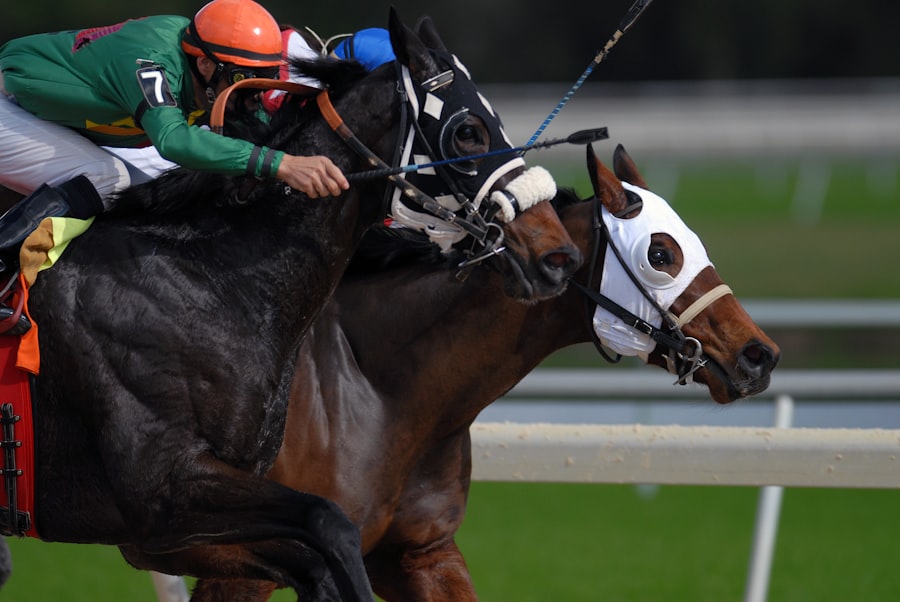The Triple Crown of Thoroughbred Racing is one of the most prestigious achievements in the sport, comprising three significant races: the Kentucky Derby, the Preakness Stakes, and the Belmont Stakes. The origins of this esteemed series can be traced back to the late 19th century. The Kentucky Derby, often referred to as “The Run for the Roses,” was first held in 1875 at Churchill Downs in Louisville, Kentucky.
This race quickly gained popularity, establishing itself as a premier event in American horse racing. The Preakness Stakes followed shortly after, with its inaugural race taking place in 1873 at Pimlico Race Course in Baltimore, Maryland. The Belmont Stakes, the final leg of the Triple Crown, was introduced in 1867 at Belmont Park in Elmont, New York, making it the oldest of the three races.
The term “Triple Crown” itself was popularized in the early 20th century. While the races had been run independently for decades, it was not until 1930 that Gallant Fox became the first horse to win all three events, solidifying the concept of a Triple Crown champion. This achievement captured the imagination of racing fans and established a benchmark for excellence in thoroughbred racing.
Over the years, the Triple Crown has evolved into a symbol of greatness, with each race presenting its own unique challenges and traditions. The history of the Triple Crown is not just about the races themselves; it encompasses the stories of legendary horses, trainers, and jockeys who have left an indelible mark on the sport.
Key Takeaways
- The Triple Crown is a prestigious horse racing achievement that dates back to the 19th century.
- The three races that make up the Triple Crown are the Kentucky Derby, the Preakness Stakes, and the Belmont Stakes.
- Only 13 horses have won the Triple Crown, making it a rare and elusive accomplishment in the world of horse racing.
- Triple Crown champions, such as Secretariat and American Pharoah, have left a lasting impact on the sport and its fans.
- Winning the Triple Crown presents unique challenges, including the grueling schedule of three races in a short period of time.
The Prestigious Races
The Kentucky Derby: “The Most Exciting Two Minutes in Sports”
The Kentucky Derby, held on the first Saturday in May, is the first leg of the Triple Crown. It is run over a distance of 1.25 miles and features a field of 20 horses, making it one of the largest fields in thoroughbred racing. The Derby is renowned for its vibrant atmosphere, complete with extravagant hats, mint juleps, and a festive spirit that draws spectators from around the world.
The Preakness Stakes: “The Run for the Black-Eyed Susans”
Following the Kentucky Derby is the Preakness Stakes, which takes place two weeks later at Pimlico Race Course. This race is celebrated for its shorter distance of 1.1875 miles and its unique tradition of draping a blanket of black-eyed Susans over the winning horse. The Preakness often serves as a pivotal moment in the Triple Crown series, as it can either set up a potential Triple Crown winner or disrupt a horse’s chances after a Derby victory.
The Belmont Stakes: “The Test of the Champion”
The final leg of the Triple Crown is the Belmont Stakes, held three weeks after the Preakness. This race is run over a grueling distance of 1.5 miles, making it the longest of the three races. The Belmont Stakes has a reputation for being particularly challenging due to its distance and often unpredictable track conditions. It is here that many horses either solidify their legacy or fall short of achieving Triple Crown glory. The Belmont Stakes has witnessed some of the most dramatic moments in racing history, including Secretariat’s record-breaking performance in 1973, which remains etched in the annals of sports lore.
The Elusive Triple Crown Winner

Achieving a Triple Crown victory is an extraordinary feat that has proven elusive throughout history. Since Gallant Fox’s triumph in 1930, only 13 horses have managed to win all three races, highlighting just how difficult it is to secure this prestigious title. The rarity of Triple Crown winners adds to the allure and mystique surrounding these races.
Each horse that has achieved this milestone has become part of an exclusive club that includes legends like Secretariat, Seattle Slew, and Affirmed. The challenges faced by horses attempting to win the Triple Crown are numerous and varied. The rigorous schedule demands that horses compete at peak performance levels over a short period, often leading to physical and mental fatigue.
Additionally, each race presents unique obstacles; for instance, the Kentucky Derby’s large field can lead to traffic issues on the track, while the Belmont’s longer distance tests a horse’s stamina like no other race. As a result, many horses that win either the Derby or Preakness fall short in their quest for the Triple Crown at Belmont Park.
Triple Crown Champions
| Triple Crown Champion | Number of Championships | Year Achieved |
|---|---|---|
| Whirlaway | 3 | 1941 |
| Citation | 3 | 1948 |
| Secretariat | 3 | 1973 |
| Seattle Slew | 3 | 1977 |
| Affirmed | 3 | 1978 |
| American Pharoah | 3 | 2015 |
| Justify | 3 | 2018 |
The list of Triple Crown champions is a testament to both equine excellence and human dedication. Secretariat remains one of the most celebrated champions in history, not only for his Triple Crown victory but also for his remarkable performance in each race. His time of 2:24 at the Belmont Stakes remains unbroken and is considered one of the greatest achievements in sports history.
Another notable champion is Affirmed, who won the Triple Crown in 1978 after an intense rivalry with Alydar, showcasing not only speed but also heart and determination. Seattle Slew made history as well by becoming the first horse to win the Triple Crown while undefeated in 1977. His remarkable journey from an unassuming foal to a champion exemplifies how talent and perseverance can lead to greatness.
More recently, American Pharoah ended a 37-year drought without a Triple Crown winner in 2015, captivating audiences with his grace and power on the track. His victory was not just a personal achievement but also a momentous occasion for racing fans who had long awaited another champion to join this elite group.
The Impact of the Triple Crown
The impact of the Triple Crown extends far beyond just horse racing; it resonates throughout American culture and society. Each year, millions tune in to watch these races, making them some of the most-watched sporting events in the country. The excitement surrounding these races generates significant economic activity for host cities through tourism, hospitality, and related industries.
Local businesses thrive during this time as fans flock to experience the pageantry and tradition associated with each event. Moreover, the Triple Crown has played a crucial role in promoting thoroughbred racing as a whole. It serves as a platform for showcasing equine talent and breeding excellence while inspiring future generations of horse enthusiasts.
The stories of past champions often become legendary tales passed down through families, fostering a deep appreciation for the sport. Additionally, successful horses can command astronomical prices at stud after their racing careers end, further fueling interest in breeding programs and elevating standards within the industry.
Challenges of Winning the Triple Crown

The Threat of Injury
Winning the Triple Crown is an extraordinary accomplishment, but it comes with numerous challenges that can thwart even the most talented horses. One significant hurdle is injury; thoroughbreds are athletes whose bodies are pushed to their limits during training and competition. A minor injury can derail a horse’s chances at any point during their campaign for glory.
The Challenge of Training and Preparation
For instance, injuries have plagued many promising contenders leading up to or during one of the Triple Crown races, leaving fans wondering what might have been. Another challenge lies in training and preparation strategies employed by trainers and owners. Each race requires specific conditioning tailored to its unique demands; thus, trainers must carefully balance training regimens to ensure their horses peak at just the right moment without overexerting them too soon.
Overcoming External Factors
This delicate balance can be difficult to achieve when considering factors such as weather conditions or changes in track surfaces that may affect performance on race day.
The Triple Crown in Popular Culture
The allure of the Triple Crown has permeated popular culture in various forms over the years. From films like “Secretariat,” which chronicles one of racing’s most iconic champions, to documentaries exploring different aspects of horse racing history, these stories resonate with audiences far beyond just sports fans. Literature has also played a role; books detailing famous races or legendary horses have captivated readers and provided insight into this fascinating world.
Moreover, celebrities often attend these prestigious events, further elevating their status within popular culture. The Kentucky Derby, in particular, has become synonymous with glamour and high society; red carpets are rolled out for stars who don elaborate outfits while mingling with racing enthusiasts. This intersection between horse racing and celebrity culture adds another layer of excitement to an already thrilling experience.
The Future of the Triple Crown
As we look toward the future of the Triple Crown, several factors will shape its evolution within both horse racing and broader society. One significant consideration is advancements in veterinary medicine and technology that may enhance training methods or improve recovery times for injured horses. These innovations could potentially lead to more competitive fields and increase opportunities for aspiring champions.
Additionally, changing demographics among racing fans may influence how these events are marketed and experienced moving forward. Younger generations are increasingly drawn to experiences that blend tradition with modernity; thus, embracing technology through social media engagement or interactive experiences could attract new audiences while preserving time-honored customs associated with each race. In conclusion, while challenges remain on multiple fronts—from ensuring equine welfare to adapting marketing strategies—the enduring legacy of the Triple Crown will likely continue captivating hearts and minds for years to come as it celebrates excellence within one of America’s oldest sports.
If you’re interested in learning more about the world of horse racing, be sure to check out this fascinating article on Race Horse Today’s shop. In addition to the excitement of the Triple Crown races, there are also insights into the latest equipment and gear used in the sport. It’s a great resource for both seasoned fans and newcomers looking to delve deeper into the world of horse racing.
FAQs
What is the Triple Crown?
The Triple Crown is a prestigious horse racing achievement in which a horse wins three specific races in the same year. The races are the Kentucky Derby, the Preakness Stakes, and the Belmont Stakes.
When did the Triple Crown races start?
The Kentucky Derby was first run in 1875, the Preakness Stakes in 1873, and the Belmont Stakes in 1867. The term “Triple Crown” was not officially used until the 1930s.
How many horses have won the Triple Crown?
As of 2021, only 13 horses have won the Triple Crown. The most recent winner was Justify in 2018.
What is the significance of winning the Triple Crown?
Winning the Triple Crown is considered one of the greatest achievements in horse racing. It is a rare and difficult feat, and the horse that accomplishes it becomes a part of racing history.
What are the distances of the Triple Crown races?
The Kentucky Derby is 1 1/4 miles, the Preakness Stakes is 1 3/16 miles, and the Belmont Stakes is 1 1/2 miles. Each race presents its own unique challenges for the horses and jockeys.















